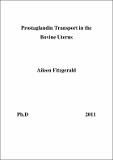| dc.description.abstract | Abstract
In the present study, the effect of bovine oestrous cycle stages and rat oestrous cycle stages were investigated for the expression of PGT protein in uterine tissue, while isolated BUECs were also examined to detect the PGT protein under different conditions. In addition, BUECs were studied to measure [3H] PG uptake, cytosolic accumulation of [3H] PG, membrane incorporation of [3H] PG, vectorial transport of [3H] PG and expression of PGT mRNA under different conditions.
PGT protein is localized in uterine luminal epithelial cells and is species and oestrous cycle stage specific, where PGT protein is confined to uterine tissue from the luteal phase (progesterone stage) in cows but is expressed in an estradiol rich environment in rat uterine tissue. The differential expression of PGT is most likely due to different lengths of each cycle and the duration in which the tissue is exposed to hormones. Furthermore, expression of PGT protein in BUECs is similar to expression in
rat uterine tissue, where estradiol increases PGT, while progesterone maintains a basal level of expression of the protein.
Transport studies indicate a phenol stimulatory effect on the uptake of [3H] PGF2a into BUECs. In addition, progesterone inhibited [3H] PGF2a uptake, an effect reversed and exacerbated when BUECs were co-cultured with progesterone and mifepristone for 72hours in media supplemented with 10% FCS. Conversely, [3H] PGF2a transport was not altered by estradiol stimulation. PUFA treatment or PUFA co-culture with estradiol did not reveal conclusive results. Increasing glucose concentration promoted the uptake of [3H] PGE2 and [3H] PGF2a in a dose dependent manner. In addition, uptake of
[3H] PGE2 and [3H] PGF2a into BUECs, treated with progesterone or estradiol increased at 2mins compared to 10mins, while the reverse is true for unstimulated cells. Neutral PGs (pH 3.0) were transported more efficiently than anionic PGs (pH 7.4) (p<0.05). Efflux studies revealed that elution of the neutral PG was higher than elution of the anionic PG. Interestingly, efflux of the neutral PG into equimolar PG was higher than efflux into saline at pH 3.0. However, efflux of the anionic compound was higher into saline than efflux into equimolar PG. In addition, efflux of [3H] PGE2 and [3H] PGF2a was time-dependent that increased linearly overtime. Vectorial flux was higher from the basolateral to the apical surfaces compared to apical to basolateral flux, suggesting greater permeability of the basolateral surface to PGs. PGT mRNA expression in BUECs was maintained at a
basal level after all treatments with subtle differences, indicating that these cells are capable of producing PGT protein at any time under these conditions.
The components and transport mechanisms of PGs are undoubtedly regimentally controlled and rely heavily on hormonal mileu, fatty acid content, energy source and is largely dependent on the ionic nature of the PG. | en_US |


